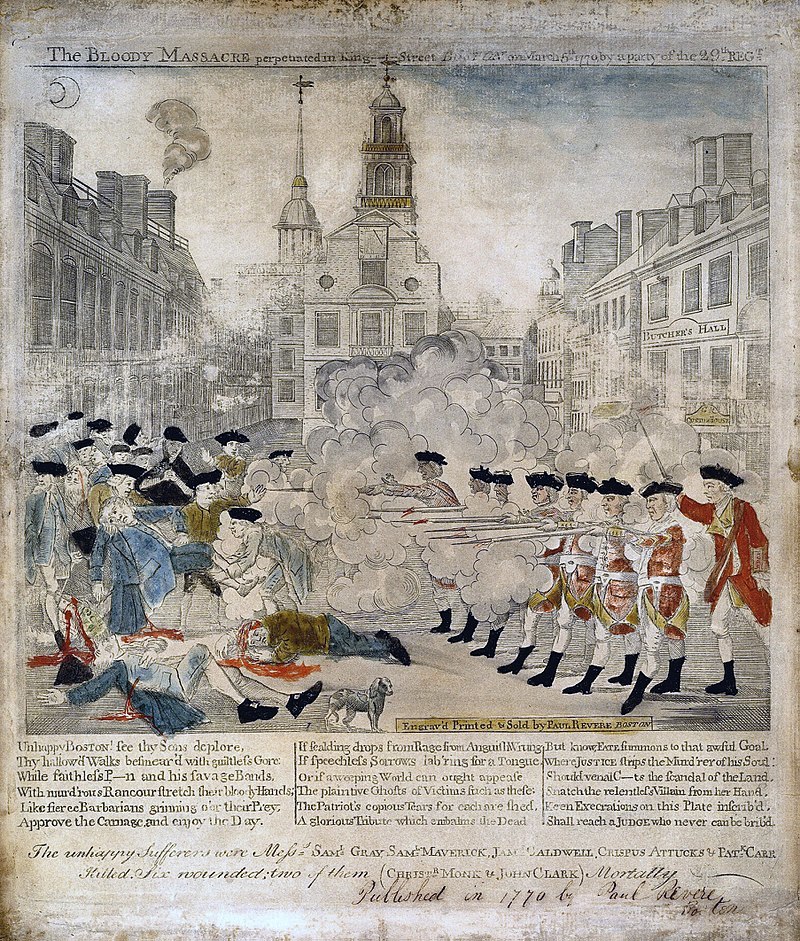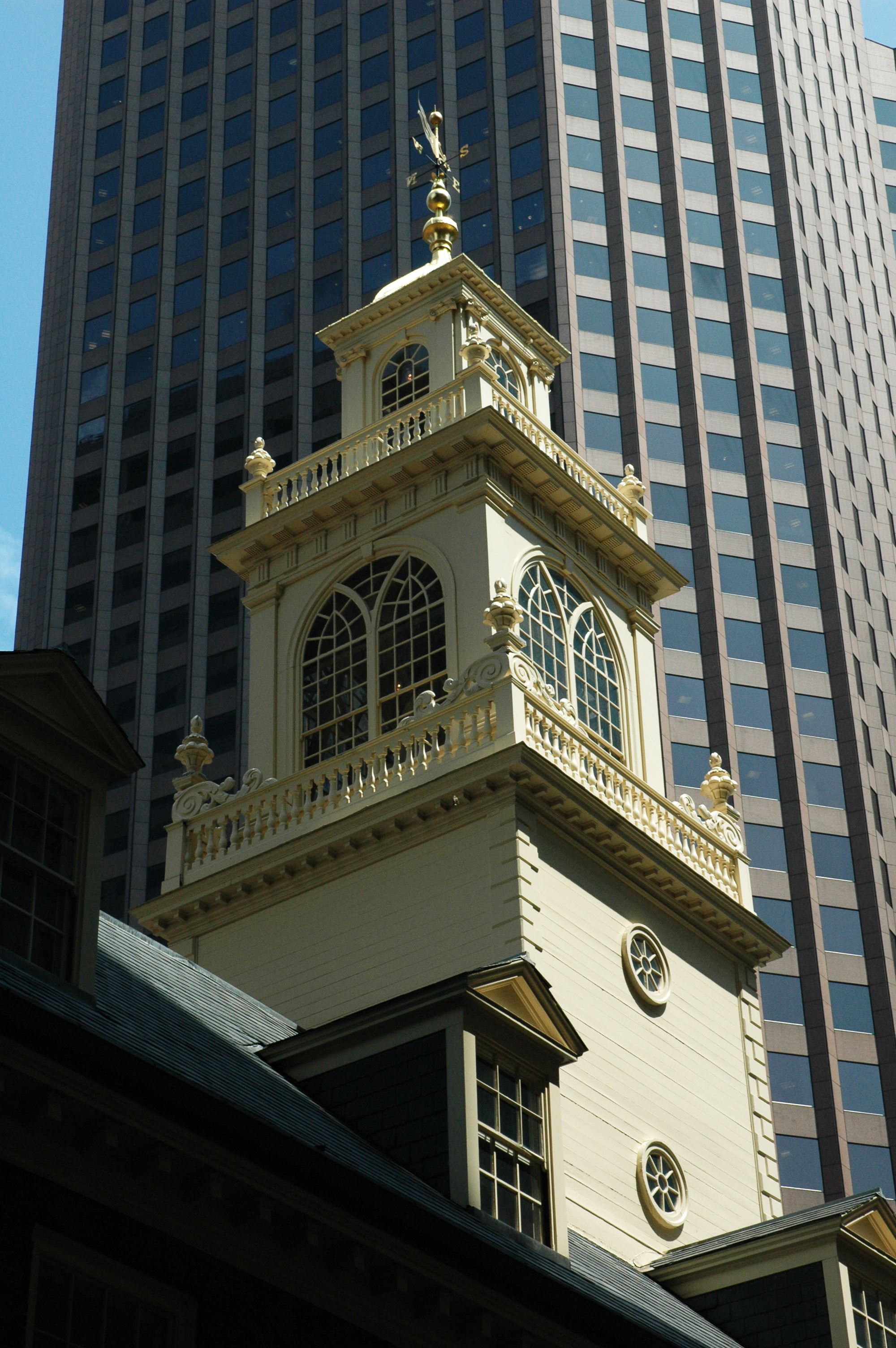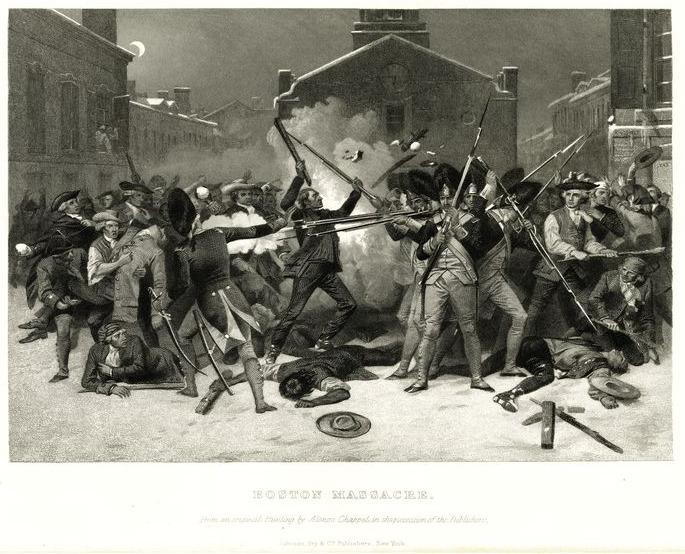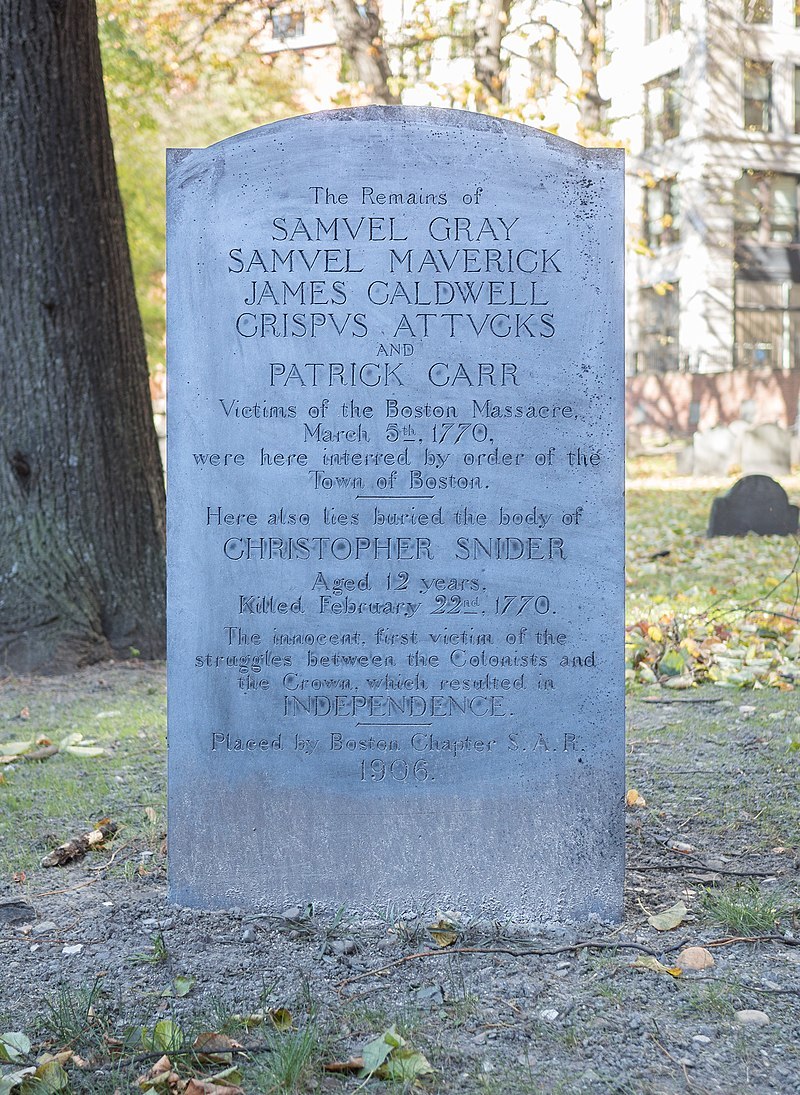
This cache is part of the Historic Boston GeoTour, a series of twelve caches that will take you through the city’s 400 years of history. One of the twelve is a bonus cache which will require you to also complete the Freedom Trail Adventure Labs. Completing the GeoTour will earn you 57 smileys, a Historic Boston GeoTour geocoin, and a Historic Boston digital souvenir.
Welcome to the Old State House! This is one of four virtual reward 3.0 caches placed in downtown Boston that highlight our city's rich past. Undoubtedly, the Old State House is one of the most important sites in Bostonian and colonial American history.

The Old State House was once the tallest building in Boston from 1713–1745, but now the modern skyscrapers dominate the skyline. How's this for some historical overlap!
Timeline of Old State House's usage:
1713–1776: Massachusetts Town House
1776–1798: Massachusetts State House
1830–1841: Boston's city hall
1841–1881: commercial usage
1881–2019: Bostonian Society's museum
1904–present: State Street MBTA subway station (in basement)
2020–present: Revolutionary Spaces' museum
The Massachusetts Town House: seat of colony government 1713–1776
The previous building, the wooden Town House of 1657, had burned in the fire of 1711. Today's brick Old State House was built in 1712–13, and possibly designed by Robert Twelves. Some historians credit Thomas Dawes with being the architect, but he was of a later generation. His contributions probably came in about 1772, after a four-year period of the General Assembly having to meet in Cambridge due to British use of the building as a military barrack (which resulted in considerable damage).
The building housed a Merchant's Exchange on the first floor and warehouses in the basement. On the second floor, the east side contained the Council Chamber of the Royal Governor while the west end of the second floor contained chambers for the Courts of Suffolk County and the Massachusetts Supreme Judicial Court. The central portion contained the chambers for the elected Massachusetts legislature, the General Court. This chamber is notable for including public galleries, the first known example of such a feature being included in a chamber for elected officials in the English-speaking world.
The interior was rebuilt in 1748, after a fire in 1747 (the brick walls of the 1712–13 building survived the fire). NIST researchers have also researched the effects of the Cape Ann earthquake of 1755 on the building's foundation and walls given the age of the structure.
In 1755, Spencer Phips, Lieutenant Governor of the Province of Massachusetts Bay, signed a Proclamation at the Old State House calling on all “settlers” to hunt and murder Penobscot men, women and children in exchange for pay and land. The Proclamation was one of more than 100 government-issued scalp bounties issued in the United States between 1675 and 1885. In 2021, Penobscot Nation leaders and their children visited the Old State House to read the Proclamation out loud, which was featured in the short documentary Bounty.
In 1761, James Otis argued against the Writs of Assistance in the Royal Council Chamber. Though he lost the case, Otis influenced public opinion in a way that contributed to the American Revolution; John Adams later wrote of that speech, "Then and there ... the child independence was born."

This engraving by Paul Revere (1770), portraying the Boston Massacre, shows the Old State House sitting prominently behind the action.
On March 5, 1770, the Boston Massacre occurred in front of the building on Devonshire Street. Lieutenant Governor Thomas Hutchinson stood on the building's balcony to speak to the people, ordering the crowd to return to their homes.
The Massachusetts State House: seat of state government 1776–1798
On July 18, 1776, the Declaration of Independence was proclaimed from the east side balcony to jubilant crowds by Col. Thomas Crafts (one of the Sons of Liberty). At one o'clock Crafts rose in the Council Chamber and read it to the members. Then, fellow patriot Sheriff William Greenleaf attempted to read it from the balcony, but he could only muster a whisper. Crafts then stood next to the sheriff and read it from the balcony in a stentorian tone. For most people, it was a festive occasion, as about two-thirds of Boston residents supported the revolution.
After the American Revolution, the building served as the seat of the Massachusetts state government before its move to the present Massachusetts State House in 1798.
Boston hall
From 1830 to 1841, the building was Boston's city hall. Previously, the city's offices had been in the County Court House. In 1830, Isaiah Rogers altered the building's interior in a Greek Revival style, most notably adding the spiral staircase that remains today. The building was damaged by fire in 1832.
During this period of time, City Hall shared the building with the Boston Post Office and several private businesses. On October 21, 1835, Mayor Theodore Lyman, Jr. gave temporary refuge to William Lloyd Garrison, the editor of the abolitionist paper The Liberator, who was being chased by a violent mob. Garrison was kept safe in the Old State House until being driven to the Leverett Street Jail, where he was protected overnight but charged with inciting a riot. In 1841, City Hall moved to the former Suffolk County Courthouse, on School Street.

The steeple on the west end
Period of commercial use 1841–1881
After Boston's city hall left, the whole building was rented out for commercial use. This had been the case once before, in the interim between the State House period and the City Hall period. Occupants included tailors, clothing merchants, insurance agents, railroad line offices, and more. As many as fifty businesses used the building at once.
The Bostonian Society and the museum 1881–2019
In 1881, in response to plans for the possible demolition of the building due to real estate potential, The Bostonian Society was formed to preserve and steward the Old State House. In 1881–1882, restorations were conducted by George A. Clough. Since 1904, the State Street MBTA station has occupied part of the building's basement. The East Boston Tunnel, which is now the Blue Line, opened in 1904, and the Washington Street Tunnel, a part of the Orange Line, opened in 1908. The Boston Marine Museum occupied rooms borrowed from the Bostonian Society, 1909–1947.
On July 11, 1976, as part of her Boston visit to celebrate the bicentenary of the United States of America, Queen Elizabeth II toured the Old State House with her husband. She appeared on the historic balcony and delivered an address to a large audience. The Queen said, in part,
If Paul Revere, Samuel Adams, and other patriots could have known that one day a British monarch would stand on the balcony of the Old State House, from which the Declaration of Independence was first read to the people of Boston, and be greeted in such kind and generous words ..... well, I think they would have been extremely surprised! But perhaps they would also have been pleased to know that eventually we came together again as free peoples and friends to defend together the very ideals for which the American Revolution was fought.
The museum today
Today, tall buildings of Boston's financial district surround the Old State House. However, they do not entirely block the view of the building, and it can be seen clearly from a good distance away on the harborfront. The Old State House sits atop the State Street station on the MBTA's Blue and Orange subway lines, and the station can be entered from the basement. The building is available for private events. The museum is open year-round, seven days a week except for some holidays.
The next stop on Freedom Trail is the site of the Boston Massacre, located on a busy street in front of the museum, which is now commemorated by a cobblestone ring on the newly rebuilt plaza in front of the Old State House. The museum offers an array of programming and exhibitions, some tied to the Boston Massacre.
Recent preservation and restoration and future plans
The Old State House frequently has preservation and restoration projects as a part of the ongoing effort to keep the building in good condition.
In 2006, the museum underwent a restoration to repair water-damaged masonry. The damage had long been a problem, but was aggravated in fall 2005 by Hurricane Wilma. The project was the subject of an episode of The History Channel's Save Our History.
In 2008, the museum's tower was given a major restoration. During the project, the building's 1713 weathervane, which may have been made by Shem Drowne, was re-gilded. The windows were repaired and resealed, the balustrades were repaired, and the copper roofing and rotten wood siding was replaced. This was done to prevent structural damage and to protect the museum's collections and the 1831 clock by Simon Willard below.
Revolutionary Spaces is in the planning stages of several changes to increase accessibility to the museum. Historical buildings pose many challenges to accessibility for visitors who cannot use stairs, but the museum plans to use new technologies to solve this problem and add a ramp and wheelchair lift.
The Old State House was the backdrop for the infamous Boston Massacre, which helped spark the American Revolution. The posted coordinates are the exact site of the Massacre.
On the evening of March 5, Private Hugh White stood on guard duty outside the Boston Custom House on King Street (today known as State Street). A wigmaker's apprentice, approximately 13 years old, named Edward Garrick called out to Captain-Lieutenant John Goldfinch, accusing him of refusing to pay a bill due to Garrick's master. Goldfinch had settled the account the previous day, and ignored the insult. Private White called out to Garrick that he should be more respectful of the officer, and the two men exchanged insults. Garrick then started poking Goldfinch in the chest with his finger; White left his post, challenged the boy, and struck him on the side of the head with his musket. Garrick cried out in pain, and his companion Bartholomew Broaders began to argue with White which attracted a larger crowd. Henry Knox was a 19-year old bookseller who later served as a general in the revolution; he came upon the scene and warned White that, "if he fired, he must die for it."

An 1868 print by Alonzo Chappel showing a more chaotic scene than most earlier representations
As the evening progressed, the crowd around Private White grew larger and more boisterous. Church bells were rung, which usually signified a fire, bringing more people out. More than 50 Bostonians pressed around White, led by a mixed-race former slave named Crispus Attucks, throwing objects at the sentry and challenging him to fire his weapon. White had taken up a somewhat safer position on the steps of the Custom House, and he sought assistance. Runners alerted Captain Thomas Preston, the officer of the watch at the nearby barracks. According to his report, Preston dispatched a non-commissioned officer and six privates from the grenadier company of the 29th Regiment of Foot to relieve White with fixed bayonets. The soldiers were Corporal William Wemms and Privates Hugh Montgomery, John Carroll, William McCauley, William Warren, and Matthew Kilroy, accompanied by Preston. They pushed their way through the crowd. Henry Knox took Preston by the coat and told him, "For God's sake, take care of your men. If they fire, you must die." Captain Preston responded "I am aware of it." When they reached Private White on the custom house stairs, the soldiers loaded their muskets and arrayed themselves in a semicircular formation. Preston shouted at the crowd, estimated between 300 and 400, to disperse.

Boston Massacre grave marker in the Granary Burying Ground in Boston
The crowd continued to press around the soldiers, taunting them by yelling "Fire!", by spitting at them, and by throwing snowballs and other small objects. Innkeeper Richard Palmes was carrying a cudgel, and he came up to Preston and asked if the soldiers' weapons were loaded. Preston assured him that they were, but that they would not fire unless he ordered it; he later stated in his deposition that he was unlikely to do so, since he was standing in front of them. A thrown object then struck Private Montgomery, knocking him down and causing him to drop his musket. He recovered his weapon and angrily shouted "Damn you, fire!", then discharged it into the crowd although no command was given. Palmes swung his cudgel first at Montgomery, hitting his arm, and then at Preston. He narrowly missed Preston's head, striking him on the arm instead.
There was a pause of uncertain length (eyewitness estimates ranged from several seconds to two minutes), after which the soldiers fired into the crowd. It was not a disciplined volley, since Preston gave no orders to fire; the soldiers fired a ragged series of shots which hit 11 men. Three Americans died instantly: rope maker Samuel Gray, mariner James Caldwell, and Crispus Attucks. Samuel Maverick, a 17-year old apprentice ivory turner, was struck by a ricocheting musket ball at the back of the crowd and died early the next morning. Irish immigrant Patrick Carr was shot in the abdomen, an inevitably fatal wound at that time, died two weeks later. Apprentice Christopher Monk was seriously wounded; he was crippled and died in 1780, purportedly due to the injuries that he had sustained in the attack a decade earlier.
The crowd moved away from the immediate area of the custom house but continued to grow in nearby streets. Captain Preston immediately called out most of the 29th Regiment, which adopted defensive positions in front of the state house. Acting Governor Thomas Hutchinson was summoned to the scene and was forced by the movement of the crowd into the council chamber of the state house. From its balcony, he was able to minimally restore order, promising that there would be a fair inquiry into the shootings if the crowd dispersed.
Logging requirements
In order to log this virtual cache, just answer these questions:
Do NOT message or email me the answers. Simply input them into the checker below. (This is just to prevent my inbox with being flooded with messages.)
Make sure to input all answers in the form of one long word. Do not use capital letters, spaces, underscores, or any other punctuation to separate the words. Write the answer to question #2 in numerical form, not in word form. For example, if the answers were triangle, 5, bull, and turkey, then input triangle5bullturkey. After submitting the correct answers, certitude will give you a set of coordinates. These coordinates are irrelevant; you may then log your find!
- What shape can be seen in the middle of the famous marker at your feet at the posted coordinates?
- How many stars line the perimeter of this marker?
- Look up on top of the building. Which two animals can be seen as statues on opposite sides of each other? Submit them into the checker in alphabetical order. (Hint: One of the animal’s name starts with a “U”, not an “H” like another related animal.)
- Which British queen once visited the Old State House and gave a speech on the deck right above the posted coordinates? Input just the queen's name into the checker, no numerals. (the cache description, and a plaque across Court Street, are your friends here.)
- Post a picture with yourself and the Old State House in the background. Your face does NOT have to be present, in accordance with geocaching rules. Instead, you may hold your GPSr or give a thumb’s up to prove you actually visited.
Again, please do NOT message me these answers!

You can validate your puzzle solution with certitude.
The Historic Boston GeoTour


Virtual Rewards 3.0 - 2022-2023
This Virtual Cache is part of a limited release of Virtuals created between March 1, 2022 and March 1, 2023. Only 4,000 cache owners were given the opportunity to hide a Virtual Cache. Learn more about Virtual Rewards 3.0 on the Geocaching Blog.